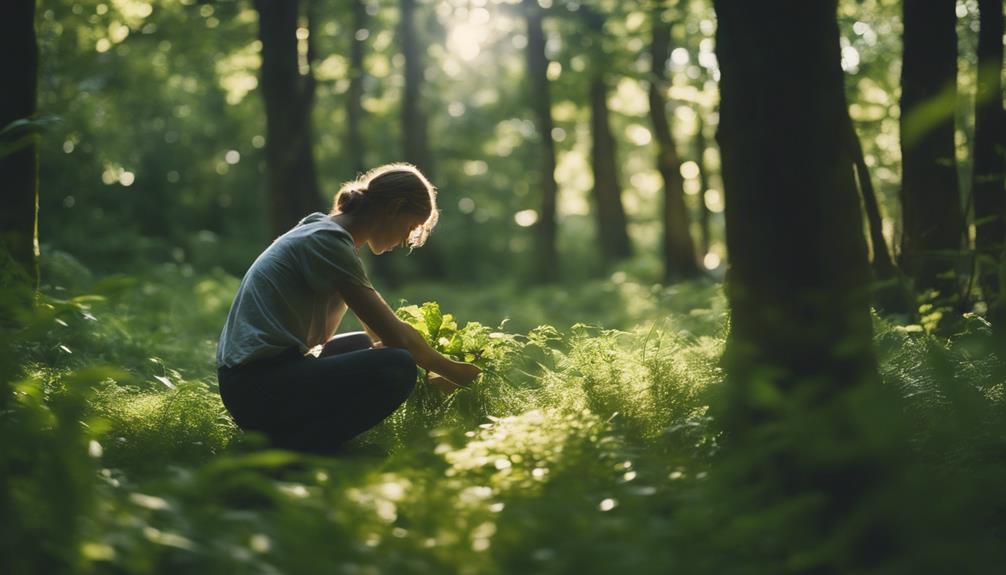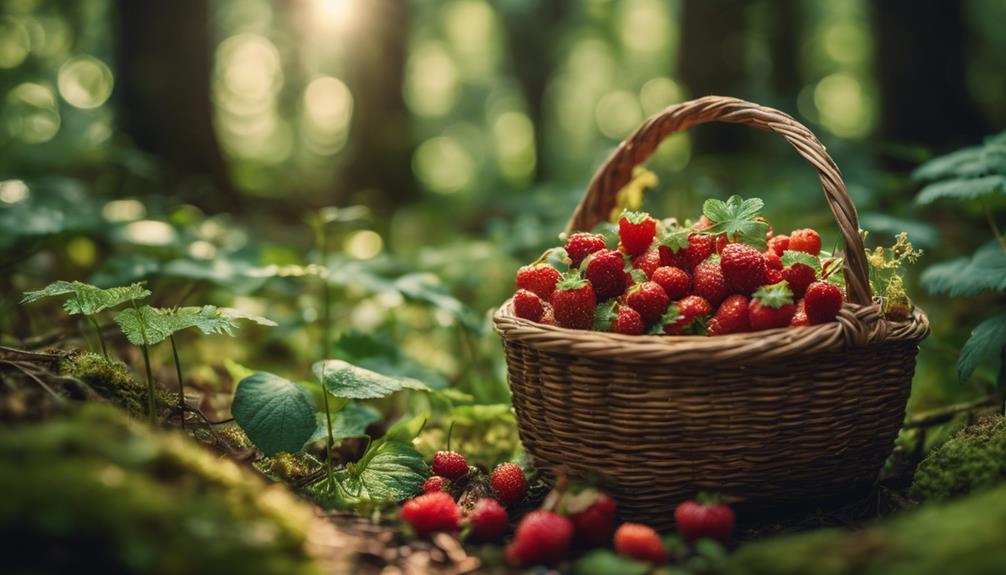When foraging on public land, research regulations beforehand, as rules vary by location. National parks often prohibit foraging, while some public lands allow it with permits. Obtaining permits supports sustainable harvesting. Before you head out, check with park authorities or landowners for guidelines and permissions. Some areas have designated foraging spots, so be sure to follow local rules for a positive experience. Remember to respect wildlife habitats and harvest in moderation to promote ecosystem health. By understanding the regulations, you can enjoy foraging on public land responsibly – and there's more to learn about doing it right.
Key Takeaways
- Research public land regulations before foraging, as rules vary by location and some areas prohibit foraging altogether.
- National parks often prohibit foraging, but some national forests allow it with permits, so check with park authorities for guidelines.
- Local and county lands may permit foraging with licenses or permission from landowners, so check with them before foraging.
- Obtaining permits supports sustainable harvesting, and understanding regulations ensures a positive experience and avoids ecological harm.
- Illegal foraging can result in fines, penalties, and environmental damage, so it's essential to understand and follow foraging restrictions.
Understanding Public Land Regulations
Before you head out to forage on public land, it's important to research and understand the specific regulations governing the area you plan to visit. Foraging on public land can be a great way to connect with nature and gather wild edibles, but it's vital to know what's allowed and what's not. Regulations can vary greatly depending on the location, so don't assume that what's allowed in one area is okay in another.
National parks, for example, typically have strict regulations against foraging to preserve the natural ecosystem and protect wildlife. On the other hand, some public lands may allow foraging for personal use with the proper permits. State parks and national forests may have limited areas where foraging is permitted, so always check with park authorities before harvesting.
Obtaining the necessary permits and following guidelines is key to maintaining the balance of ecosystems and supporting sustainable harvesting practices. Take the time to research and understand the regulations for the specific public land you plan to visit, and you'll be well on your way to a successful and responsible foraging adventure.
Where Foraging Is Allowed

As you start foraging on public land, you'll find that national parks and forests are great places to search for wild edibles.
You can also explore local and county lands, which often have designated areas for foraging.
Remember to check with local authorities or park offices for specific guidelines, as regulations may vary by location.
National Parks and Forests
When venturing into National Parks and Forests, you'll find that foraging is allowed, but with certain caveats and restrictions. While the Park Service generally discourages foraging, specific rules and regulations vary by location and park management.
In some National Forests, permits are available for harvesting forest products, which may include foraging for food. However, it's important to seek permission from landowners before foraging on public lands, including federal land. Additionally, each forest may have specific guidelines or restrictions regarding the types and quantities of products that can be collected. Always ensure that you are familiar with local regulations, as rules can vary widely between areas. Foraging on national trust land may also require additional permits or permissions depending on the management policies in place for the preservation of the area. Furthermore, some areas prioritize ecological preservation and may impose stricter limitations to protect sensitive habitats and species. It’s crucial to educate yourself about **foraging rules on National Trust** land and understand the potential environmental impact of your activities. Proper stewardship ensures that these natural resources remain available for future generations to enjoy.
Be cautious of restrictions on activities like firewood and mushroom collection in National Parks and Forests. Always check with park authorities or visitor centers for specific guidelines and regulations.
Local and County Lands
You'll find that local and county lands offer more relaxed foraging opportunities, with many public areas allowing you to search for wild edibles. Local parks, city parks, and nature preserves often permit foraging, but it's crucial to check with the specific landowner or management agency for permission.
You might need a foraging license or permit, depending on the location and the type of plants you're looking to harvest. Some state parks and nature preserves have designated foraging areas, so be sure to check with park rangers or visitor centers for information on where and what you can forage.
Additionally, community gardens and educational institutions with foraging programs may also permit foraging activities. Remember to always follow the rules and regulations for foraging on local and county lands to ensure a positive and sustainable experience for all.
Permits and Special Permissions

Before heading out to forage on public land, determine if you need a permit or special permission, as requirements vary depending on the location and type of resources you plan to harvest. Understanding the regulations is vital to make sure you're allowed to engage in permitted foraging activities on public land.
Here are three essential things to take into account:
- Location-specific permits: Different public lands, such as national forests, state parks, and managed forest areas, have unique regulations. Research the specific rules for the area you plan to forage in.
- Resource-specific permissions: Special permissions might be required for collecting certain resources like firewood, Christmas trees, plants, mushrooms, minerals, fossils, or cultural materials.
- Landowner permission: Always seek permission from landowners or relevant authorities before engaging in foraging activities on public land.
Sustainable Foraging Practices

As you venture into public lands to forage for wild plants, adopting sustainable practices is crucial to promote the long-term health and resilience of natural ecosystems. By following sustainable foraging practices, you can enjoy nature's bounty without causing harm to the environment. Sustainable foraging involves harvesting wild plants in a way that guarantees the continued growth and abundance of the species.
Here are some best practices to keep in mind:
| Sustainable Foraging Practices | Why It Matters |
|---|---|
| Leave no trace | Respects wildlife habitats and preserves the ecosystem |
| Harvest in moderation | Maintains plant populations and promotes biodiversity |
| Respect wildlife habitats | Preserves flora and fauna, ensuring long-term ecosystem health |
| Follow local regulations | Guarantees responsible and sustainable use of public lands for wild foods |
What You Can and Can't Harvest

Your foraging adventure on public land comes with certain privileges and restrictions, and knowing what you can and can't harvest is vital for a sustainable and enjoyable experience. When foraging for wild edibles on public land, it's important to understand what's allowed and what's not.
Here are a few things you're allowed to harvest for personal use:
- Firewood, Christmas trees, plants, mushrooms, and berries: You can collect these for personal use, but be sure to follow sustainable foraging practices to guarantee the land remains healthy.
- Minerals like gold and gemstones: You can collect these with hand tools, but commercial use requires permission from the Bureau of Land Management (BLM).
- Vertebrate fossils (with a BLM permit) and common invertebrate fossils: Researchers with BLM permits can collect vertebrate fossils, while common invertebrate fossils may be collected for personal use.
Remember to always follow local regulations and respect cultural materials like artifacts and historic sites, which require a BLM permit to disturb.
Consequences of Illegal Foraging

When you venture into public lands for foraging, it's crucial to understand the consequences of illegal foraging. You could face fines and penalties, such as the $500 minimum fine in Texas, and even legal action for unauthorized harvesting.
Fines and Penalties
If you're caught foraging on public land without permission, you can expect to pay a hefty fine, starting at $500 in Texas. This is a significant consequence, and it's important to understand the regulations governing foraging on public land to avoid such penalties.
Here are three important reasons to respect the regulations:
- Fines can add up: Illegal foraging can result in significant financial penalties, which can be a substantial burden.
- Penalties can escalate: Repeated offenses can lead to harsher penalties, including criminal charges in extreme cases.
- Respect for the land is crucial: Foraging without permission can damage the ecosystem and deplete natural resources, harming the environment and future generations.
Land Degradation Effects
Important foraging on public land can trigger a cascade of devastating ecological consequences, including land degradation, which disrupts ecosystems, reduces biodiversity, and harms native plant species. When you forage illegally, you're not just picking wild edibles – you're also contributing to the depletion of natural resources, impacting wildlife habitats, and disturbing the delicate balance of the ecosystem.
Over-harvesting on public land can lead to soil erosion, loss of vegetation cover, and long-term ecological harm. Trampling of vegetation, soil compaction, and introduction of invasive species are common consequences of unauthorized foraging. The damage caused by illegal foraging can have lasting effects on the environment, requiring extensive restoration efforts to repair the damage.
Legal Action Risks
Foraging on public land without permission can lead you into a legal quagmire, where fines and penalties await those who disregard the rules. As you venture into the great outdoors, it's important to understand the consequences of illegal foraging on public land.
When you forage without permission, you risk facing legal action, including fines and penalties. Here are some potential consequences to take into account:
- Fines: In Texas, for example, fines for illegal foraging can start at $500.
- Legal charges: You may face legal charges, which can lead to a criminal record.
- Environmental damage: Illegal foraging can harm the environment, causing long-term damage to the ecosystem.
Understanding and following foraging restrictions and guidelines is crucial to avoid legal action. Remember, it's always better to err on the side of caution and obtain the necessary permits or permissions before foraging on public land.
Frequently Asked Questions
Can You Forage in Local Parks?
You're wondering if you can forage in local parks, but generally, it's discouraged to preserve natural resources, although some states offer permits for limited activities, so always seek permission from park authorities before foraging.
What Is the Foraging Rule?
You're wondering what the Foraging Rule is – it's a set of guidelines regulating the harvesting of wild plants and resources on public land, varying by location, to balance conservation and sustainable foraging practices.
In What States Is Foraging Illegal?
You'll find that foraging is illegal in states like Arkansas and California, where state-owned lands are off-limits, so you'll need to explore other options or check with local authorities for specific regulations.
What Are Three Cautions Regarding Foraging?
As you venture out, veiled vistas of wild wonders await, but beware: you'll face fines for forbidden foraging, fragile habitats, and forgotten permits, so prioritize permission and sustainable practices to preserve the pristine public land.
Conclusion
As you venture into the world of foraging on public land, remember that knowledge is power.
Like a treasure hunter, you must dig through regulations and guidelines to uncover the hidden gems of edible delights.
But with great power comes great responsibility – respect the land, respect the rules, and forage sustainably, lest you face the consequences.
Happy foraging!










